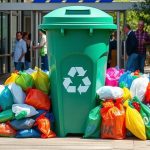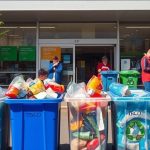Does Tesco Still Recycle Plastic Bags? Current Policy
Tesco’s plastic bag recycling has become more complex. Consumers want clear information about supermarket recycling schemes. Large Tesco stores offer soft plastic collection points as a sustainable solution.
The Everyday Plastic group and EIA UK have uncovered issues with these initiatives. They tracked 40 soft plastic bundles. Only a small portion was truly recycled. Most were burned for energy instead.
Tesco aims to turn collected plastics into community projects. These include school planters and NHS park benches. Yet, the actual process has a more complicated environmental impact.
The study found that soft plastic waste travels far. Tracked bundles covered over 25,000 kilometres across the UK and abroad. This happened between July 2023 and February 2024.
To grasp Tesco’s scheme, we must look at current recycling systems. We also need to know where collected materials really end up.
Current Status of Tesco’s Plastic Bag Recycling Programme
Tesco launched a soft plastic recycling programme in March 2021. This initiative tackles the growing plastic packaging disposal challenge across the UK. It offers an innovative approach to managing soft plastic waste.
Types of Plastic Accepted at Collection Points
Tesco’s recycling points simplify soft plastic collection for customers. The programme accepts various plastic packaging types.
- Bread bags
- Fruit and vegetable packaging
- Crisp packets
- Salad bags
- Pasta packaging
- Rice packaging
Store Locations and Accessibility
The recycling scheme has grown significantly since its start. Tesco soft plastic collection points are now available at every large Tesco store across the UK. This makes it easy for customers to dispose of plastic waste responsibly.
Our goal is to recover over 80% of the soft plastic returned by customers, creating a more sustainable approach to packaging waste.
Independent studies show that about 70% of collected soft plastic is burned. This highlights the complex nature of plastic recycling. The process faces challenges despite good intentions.
Tesco aims to collect over 1,000 tonnes of plastic yearly through this scheme. This shows a strong commitment to environmental sustainability and waste reduction.
Are Tesco Still Recycling Plastic Bags?
Tesco’s plastic bag policy showcases their dedication to eco-friendly practices. They’ve set up soft plastic collection points in about 900 UK stores. Tesco’s recycling programme offers an easy way to dispose of tricky plastic packaging.
The recycling scheme has shown impressive results. During regional trials, they collected nearly one tonne of soft plastic daily. Over 80% of returned soft plastic was recovered.
Tesco expects to gather more than 1,000 tonnes of soft plastic yearly. Customers can return various items like bread bags and crisp packets.
- Collection of nearly 1 tonne of soft plastic per day during regional trials
- Recovery of over 80% of soft plastic returned by customers
- Expectation to collect more than 1,000 tonnes of soft plastic annually
Customers can return various soft plastic items, including:
- Bread bags
- Fruit and vegetable packaging
- Crisp packets
- Salad bags
- Baby and pet food pouches
Tesco goes beyond just collecting plastic. They’ve turned some recycled soft plastic into packaging for their own-brand cheeses. This shows a circular approach to plastic management.
Our plastic recycling programme represents a significant step towards reducing waste and promoting sustainability in the retail sector.
However, challenges persist in plastic waste management. About 20% of collected soft plastic is used for energy recovery. This highlights the ongoing complexities of fully recycling all plastic waste.
The Reality of Tesco’s Recycling Process
Tesco’s plastic waste management reveals a complex journey of collected materials. The retail giant currently recycles 83% of its packaging. They aim to increase this to 90% soon.
The recycling process involves several critical stages. These determine the fate of plastic materials collected from stores. Many challenges exist in managing soft plastics and complex packaging.
Journey of Collected Plastics
Tesco’s recycling pathway involves multiple critical steps:
- Collection at designated store recycling points
- Sorting of different plastic types
- Evaluation of material recyclability
- Processing through specialised recycling technologies
Final Destination of Materials
Not all collected plastics achieve complete recycling. Current practices show varied outcomes.
- Approximately 65,000 tons of plastics may be processed annually
- Some plastics are incinerated for energy recovery
- Certain materials might be exported overseas
- Soft plastics remain particularly challenging to recycle
Recycling Technologies is developing 1,300 processing machines to enhance soft plastic recycling. This could double the UK’s plastic waste recycling potential.
This innovative approach aims to reduce landfill waste. It also creates more sustainable waste management solutions.
Environmental Impact and Transparency Issues
UK supermarkets face significant challenges in plastic waste reduction. A study revealed that 70% of plastic packaging from Tesco and Sainsbury’s was incinerated. This finding questions the effectiveness of their recycling programmes.
The UK produces about 100 billion pieces of plastic packaging yearly. It ranks second globally in per capita plastic waste production. Recycling infrastructure struggles to keep pace with consumption.
Only 13% of UK households can recycle soft plastics through kerbside services. This limited access hampers recycling efforts nationwide.
- Only 25% of soft plastics can be recycled domestically
- 88% of local authorities do not collect soft plastics for recycling
- 215 billion new soft plastic items entered the UK market in 2023
Transparency in recycling practices remains a major concern. Tesco’s pledge to recover 80% of returned soft plastics has come under scrutiny. Investigations show most collected materials are burned or exported.
About 80% of soft plastics are downcycled and sent abroad, mainly to Turkey. This practice raises questions about the true environmental impact of recycling efforts.
The UK’s recycling capacity would need to increase by 350% to manage current plastic waste volumes.
Consumer awareness of soft plastic recycling is growing, with 96% of Brits recognising its importance. The UK Plastics Pact aims to recycle 70% of packaging by 2025. It also seeks to eliminate single-use plastics.
Conclusion
Plastic recycling at Tesco faces major hurdles in achieving sustainable shopping. Only 17% of plastic waste gets recycled in the UK. Sadly, 70% of collected soft plastic ends up being burned.
Tesco’s efforts to reduce plastic waste are promising. They’ve removed one billion plastic pieces and set up 900 collection points. Their goal is to make all packaging recyclable by 2025.
Shoppers can make a difference by taking part in recycling programmes. Choosing products with less packaging also helps. Supporting eco-friendly retailers is another way to contribute to environmental progress.
The future of plastic recycling relies on teamwork. Supermarkets, consumers, and waste management systems must work together. Despite challenges, ongoing talks and small improvements offer hope.
These steps could lead to better plastic waste management in the UK. It’s a complex issue, but positive change is possible with continued effort.
FAQ
What types of plastic can I recycle at Tesco stores?
Tesco accepts many soft plastics at their large UK stores. You can recycle bread bags, fruit packaging, crisp packets, and salad bags. Look for collection points in these stores.
How do I prepare my plastic for recycling at Tesco?
Clean and dry your plastic items before recycling. Remove non-plastic parts like labels or clasps. Flatten or scrunch the plastic to save space at collection points.
Are Tesco’s plastic recycling collection points available in all stores?
All large Tesco stores in the UK have collection points. Smaller local shops might not offer this service. Check with your nearest store to be sure.
What happens to the plastic after it’s collected?
Collected plastics go through sorting. Tesco tries to recycle as much as possible. Some materials may be used for energy recovery through incineration.
Can I recycle plastic packaging from other supermarkets at Tesco?
Tesco’s programme is mainly for their own plastics. They might accept some external packaging. Ask store staff about specific rules.
How effective is Tesco’s plastic recycling programme?
The programme’s success varies due to soft plastic recycling challenges. Tesco is open about this and works to improve their methods. They aim to reduce plastic waste overall.
What environmental impact does Tesco’s plastic recycling have?
Tesco’s recycling helps reduce plastic waste in landfills. It promotes eco-friendly shopping habits. The programme supports broader efforts to cut down on waste.
Are there any costs associated with recycling plastic at Tesco?
No, Tesco’s plastic recycling is free for customers. This service encourages responsible waste management and environmental care.
How can I stay informed about Tesco’s recycling initiatives?
Visit Tesco’s website for updates on their recycling programme. You can also follow their sustainability news or ask store staff for information.
What alternatives does Tesco offer to reduce plastic usage?
Tesco offers reusable bags to cut down on plastic. They’re reducing packaging and creating more sustainable options. Look for these changes in their own-brand products.















